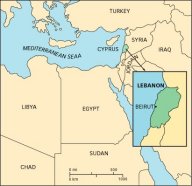


Page 3 of 6
In March 1978, following a raid on Israel by Al Fatah guerrillas based in Lebanon, Israeli forces invaded and occupied southern Lebanon which they quickly came to regard as a buffer to protect Israel’s northern boundary. The United Nations Security Council approved a resolution demanding that Israel should cease hostilities and withdraw from Lebanese territory. The same resolution provided for the formation of a UN Interim Force in Lebanon (UNIFIL) to monitor Israel’s withdrawal and to restore order to the country but, when the Israelis withdrew in June 1978, they handed southern Lebanon over, not to the Lebanese Government, but to the predominantly Lebanese Christian militias with which Israel had close links and a political understanding.
With southern Lebanon now effectively under Israeli control (albeit through surrogates), with continuing fighting between the Syrian forces and Christian militias in and around Beirut, further efforts by Arab countries, including Saudi Arabia, to restore Lebanon’s territorial integrity and political unity were once again frustrated.
In 1982, Israeli air raids provoked the PLO into shelling northern Israel. Israel’s response was a full-scale invasion of Lebanon. The Syrian forces were driven back into the Beka’a Valley but Israel’s main target was the PLO. The primary tactic used by Israel was heavy and indiscriminate bombardment of Lebanese towns and cities with the intention of undermining the morale of the Lebanese people. Press reports estimated that 14,000 people were killed by the Israeli forces in the first two weeks of the invasion, 80% of whom were civilians. Throughout July and August of that year, Israel maintained a constant bombardment of West Beirut and cut off water, food, electricity and medical supplies. At the end of August, the PLO agreed to withdraw from what was left of the city.
In September, with the connivance and encouragement of the occupying Israeli forces (under the command of Ariel Sharon, the then Minister of Defense), Phalangist militiamen were sent into the Palestinian refugee camps of Sabra and Chatila in a “cleaning up” operation. Following the enforced departure of the PLO, the camps were now unprotected, although Israel had guaranteed the safety of the residents and the United States had agreed to use its influence to ensure Israel kept its word. According to Red Cross sources, some 2,750 refugees were butchered. Many of them were women and children. The motive of the Phalangist militiamen who carried out the slaughter was primarily bloodlust. Israel’s motive had more to do with its policy of ethnic cleansing.

